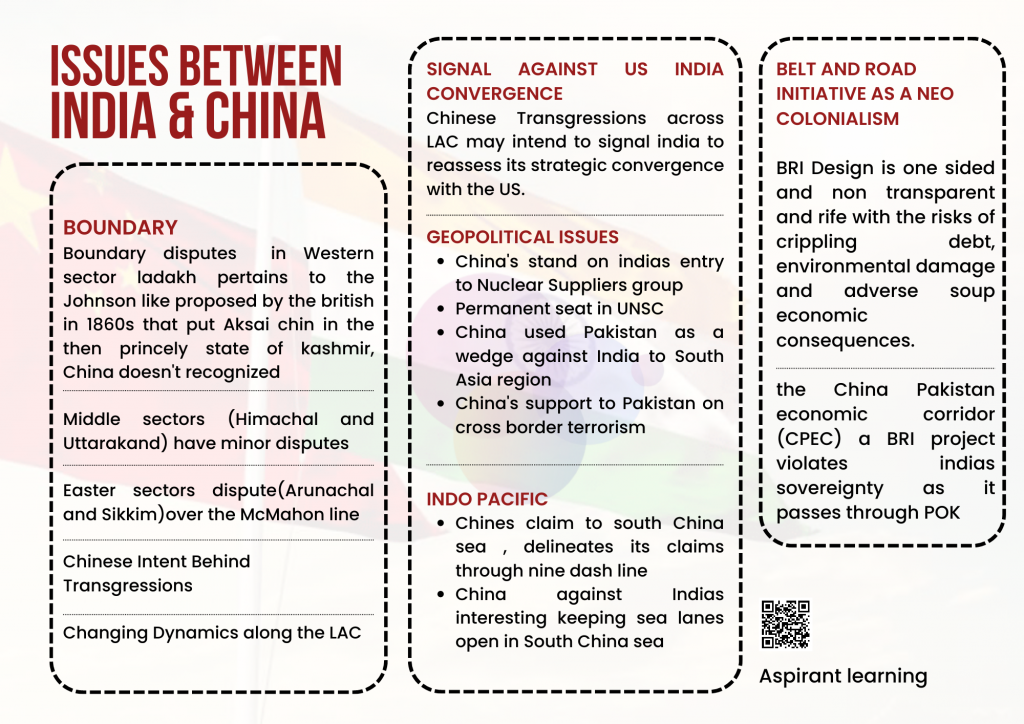News Highlight:
- As per the United Nations population survey, China will not be the most populous society on earth.
- Instead, India will have the largest population, and China will be second.
Key Takeaway:
It’s a rare example of a global ranking where India sits higher than China.
India-China relations:
- Background:
- India and China established diplomatic relations on 1st April 1950.
- India was the first non-socialist country to establish relations with the People’s Republic of China and the catchphrase ‘Hindi Chini Bhai Bhai’ became famous.
- In 1962 the border conflict led to a serious setback in bilateral relations. India and China did not break off their diplomatic relations, but both sides withdrew their ambassadors and closed the Consulate General.
- In 1976, China and India restored ambassadorial relations and bilateral ties improved gradually.
- Indian Prime Minister Rajiv Gandhi visited China, initiating the process of normalization of bilateral relations.
- The two sides agreed to look forward and develop bilateral relations actively in other fields while seeking a mutually acceptable solution to boundary questions.
- Political Aspect:
- In 1993, Agreement on the Maintenance of Peace and Tranquility along the Line of Actual Control (LAC) on the India-China Border Areas was signed to bring stability and substance in bilateral ties.
- In 2008, two countries have also extended their strategic and military relations.
- MoU was signed to open an additional route for Kailash Mansarovar Yatra through Nathu La.
- India and China have also established a High Level Dialogue Mechanism on Counter-Terrorism and Security
- During the visit of President Xi Jinping to India in September 2014, the two sides redefined the bilateral engagement as Closer Developmental Partnership.
- To facilitate exchanges between Indian states and Chinese provinces, States/Provincial Leaders Forum was established
- India and China have set up 20 Inter-parliamentary friendship groups.
- Commercial and Economic Relations:
- China forms an integral part of the global supply chain, and India heavily depends on Chinese imports. India-China trade went up to over $67 billion in the first half of 2022.
- In 2019, the trade volume between China and India was $92.68 billion.
- China accounted for over 5% of India’s total exports in the financial year 2019-20 and more than 14% of imports.
- Both countries enjoy huge potential and broad economic and trade cooperation prospects.
- Cultural Perspective:
- India and China shared deep cultural norms, primarily through Buddhism, which shaped both societies.
- Chinese philosopher Hu Shih once said that India conquered China culturally for 20 centuries without ever sending a soldier across its border, which symbolises the rich history of cultural ties between the two civilisations.
- India and China have agreed on the co-production of movies
- Yoga is becoming increasingly popular in China. China was one of the co-sponsors to the UN resolution designating June 21 as the International Day of Yoga
- Education Relations:
- India and China signed Education Exchange Programme (EEP), an umbrella agreement for educational cooperation between the two countries.
- Chinese students are also annually awarded scholarships to study Hindi at Kendriya Hindi Sansthan to learn Hindi
- Technological Aspect:
- India and China have held Joint Research workshops on Science and Technology Innovation.
- India and China have enabled each other’s rise as emerging technology powerhouses, and Chinese tech giants have invested billions of dollars into India’s biggest startups.
- China’s smartphone makers dominate the country’s market. Indian companies have set up IT corridors in China. With its technological edge in electric vehicles and lithium batteries, China could make and sell more electric cars in India than any other manufacturer shortly.
- Defence:
- Defence cooperation and military engagement between India and China are aspects of the complex mix of conflict and cooperation approaches to bilateral.
- Both countries recognise the framework and postulates of cooperative security
- The two countries have also extended their strategic and military relations. China-India Hand-in-Hand Joint Anti-terrorists Training started in December 2008 at Belgaum in Karnataka.
- The joint military exercise was carried out according to the Memorandum of Understanding for exchange and cooperation in the field of Defence signed in 2006 and listed in the annual exchange plan for 2008.
- The eighth edition was held in India in 2019.
- Indian diaspora:
- Presently, around 35,500 Indians are staying in China, and students and working professionals comprise it.
- PICFA” Pondicherry India China friendship association is an NGO dedicated to developing people-to-people relations between India and China in education, culture and tourism.

Issues between India and China:
- Border:
- The boundary dispute in the Western Sector (Ladakh) pertains to the Johnson Line proposed by the British in the 1860s that put Aksai Chin in the then princely state of Kashmir. China, however, does not recognize it and instead accepts Macartney–MacDonald Line which puts Aksai Chin under its control.
- The dispute is minor in the Middle Sector (Himachal Pradesh and Uttarakhand).
- The eastern sector (Arunachal Pradesh and Sikkim) is over the McMahon Line (in Arunachal Pradesh) decided in 1914 in a meeting of Representatives of China, India, and Tibet in Shimla. Though the Chinese representatives at the meeting initiated the agreement, they refused to accept it.
- Changing Dynamics Along the LAC:
- India has been upgrading its roads and military infrastructure around LAC. Lately, India completed the which connects Leh to the Karakoram Pass.
- India also maintains a key landing strip at DBO at 16,000 feet. India is rapidly catching up with China, which already enjoys an advantage in both terrain and infrastructure.
- In this context, the stand-off in Ladakh appears to have been triggered by China to obstruct border infrastructure upgradation activity by India.
- Arousing Nationalist Sentiments:
- Experts on Chinese foreign policy believe China’s aggressive posture is focused not only along the LAC but on Hong Kong, Taiwan and the South China Sea. These developments aim to divert attention from the domestic economic crisis towards a nationalist sentiment.
- Geopolitical Issues:
- China’s stand on India’s entry into the Nuclear Suppliers Group (NSG), permanent seat in the United Nations Security Council (UNSC),
- China has used Pakistan as a wedge against India to confine India to the South Asia region and prevent India’s rise as a global competitor.
- China’s support to Pakistan on cross-border terrorism,
- Resistance to the designation of certain terrorists globally (Masood Azharin UNSC 1267 list),
- China’s open reception of the new Taliban rulers of Afghanistan.
- Indo-Pacific:
- The Chinese claim to the South China Sea is based on history. It delineates its claims through the famous“nine-dash line” which claims almost the entire SCS.
- India is strongly interested in keeping sea lanes open in the South China Sea. Almost 55% of India’s trade with Asia-Pacific passes through the South China sea.
- BRI (Belt and Road Initiative) Neo-Colonialism:
- The BRI is not simply an infrastructure and connectivity initiative but a geopolitical design to establish Chinese dominance.
- The BRI design is one-sided, non-transparent and rife with the risks of crippling debt, environmental damage, and adverse socio-economic consequences.
- The China-Pakistan Economic Corridor (CPEC):
- The China-Pakistan Economic Corridor (CPEC) – a BRI project – violates India’s sovereignty, as it traverses Pakistan-Occupied Kashmir, a territory claimed by India and illegally occupied by Pakistan.
- The string of Pearls:
- String of Pearls refers to the Chinese intention to establish a network in India Ocean Region (IOR) surrounding India.
- Each pearl represents some form of permanent Chinese installation in a series of locations in IOR.
Way Forward:
India-China should properly handle the historical and practical problems in the bilateral relations and care for each other’s concerns while increasing trust and dispelling doubts. It is crucial for the two countries not to sharpen rhetoric against each other and look for a pragmatic solution to the existing problems between the two countries.
Pic Courtesy: The Hindu
Content Source: The Hindu



